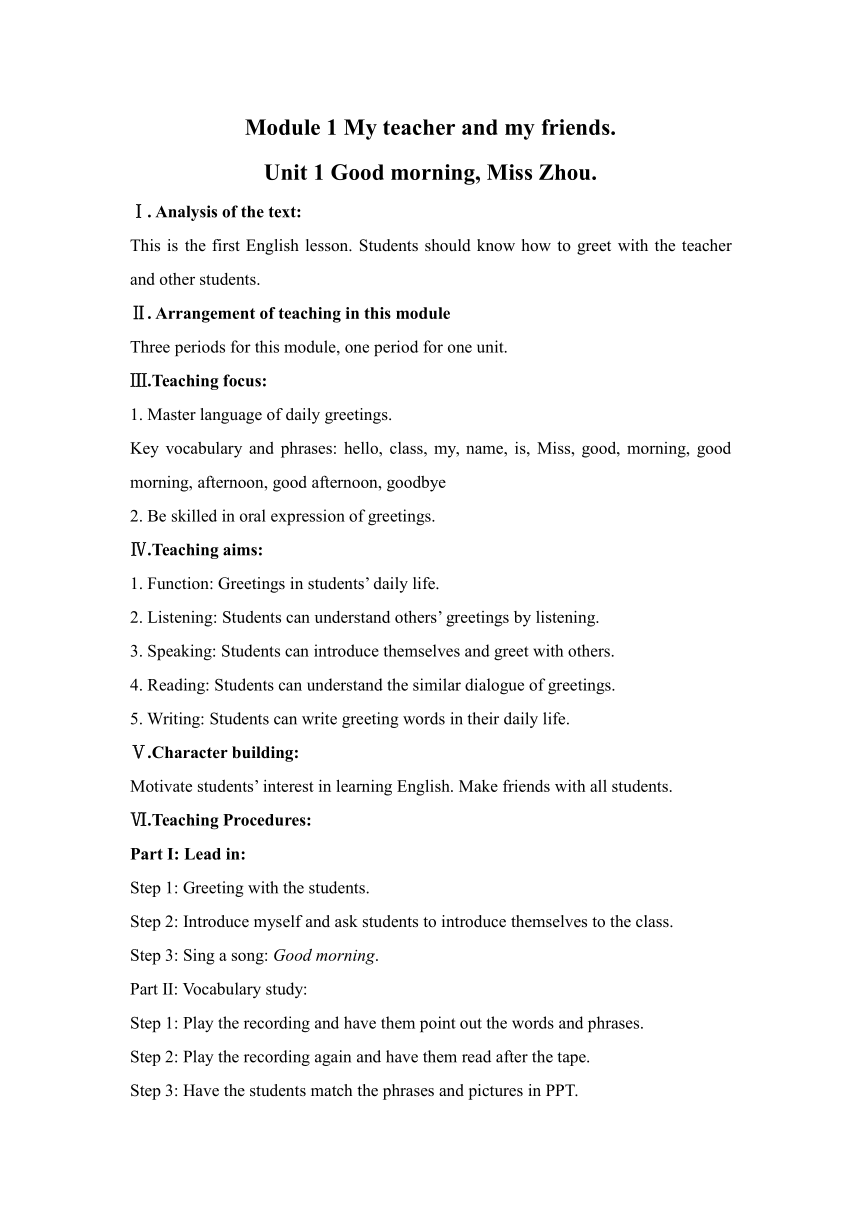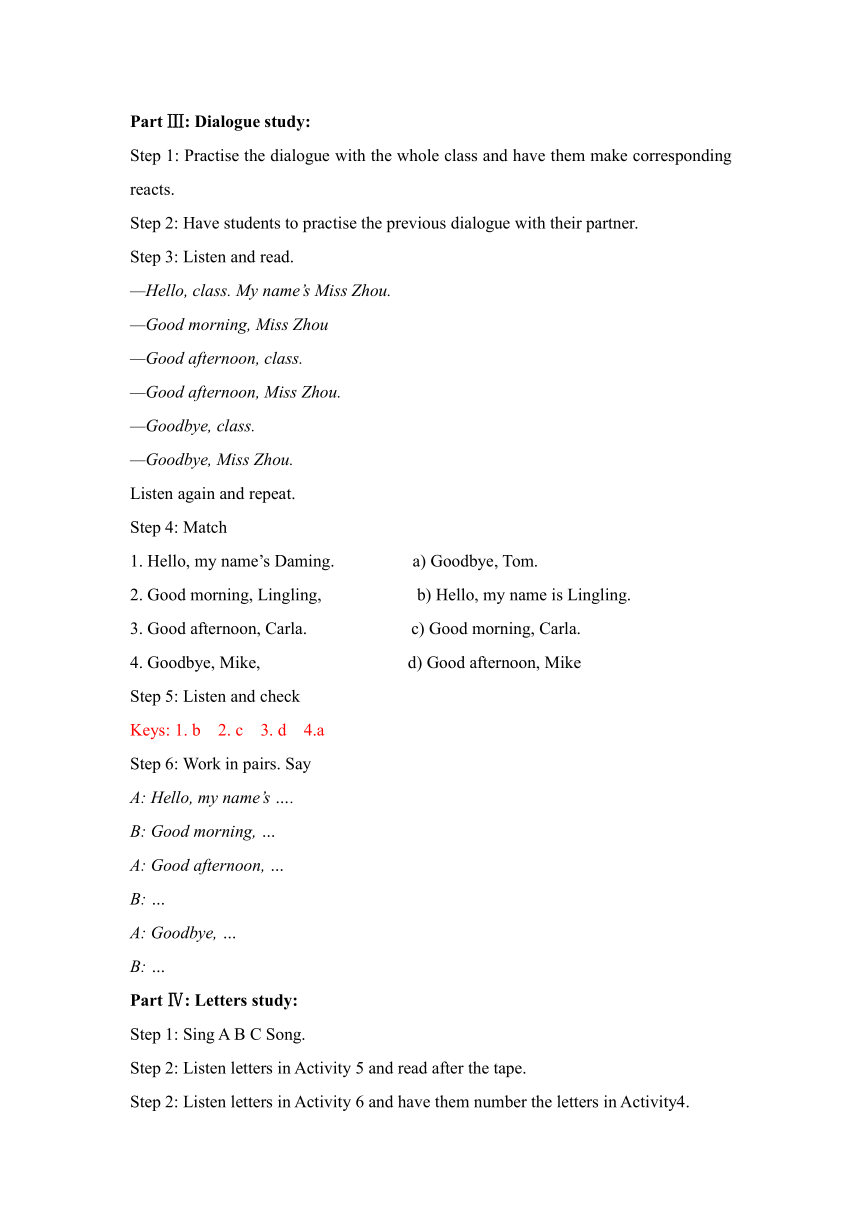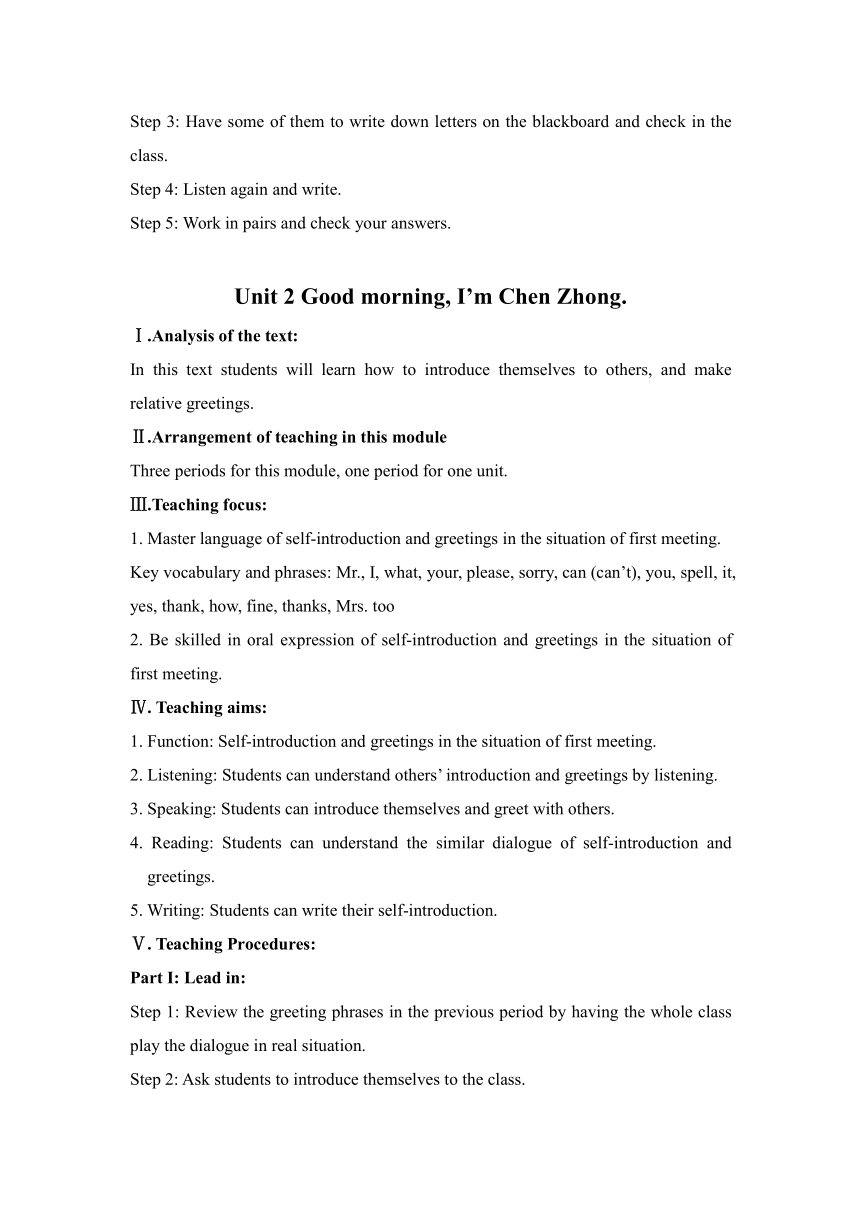Starter>Module 1 My teacher and my friends.模块教案
文档属性
| 名称 | Starter>Module 1 My teacher and my friends.模块教案 |  | |
| 格式 | zip | ||
| 文件大小 | 9.6KB | ||
| 资源类型 | 教案 | ||
| 版本资源 | 外研版 | ||
| 科目 | 英语 | ||
| 更新时间 | 2013-09-24 22:51:28 | ||
图片预览



文档简介
Module 1 My teacher and my friends.
Unit 1 Good morning, Miss Zhou.
Ⅰ. Analysis of the text:
This is the first English lesson. Students should know how to greet with the teacher and other students.
Ⅱ. Arrangement of teaching in this module
Three periods for this module, one period for one unit.
Ⅲ.Teaching focus:
1. Master language of daily greetings.
Key vocabulary and phrases: hello, class, my, name, is, Miss, good, morning, good morning, afternoon, good afternoon, goodbye
2. Be skilled in oral expression of greetings.
Ⅳ.Teaching aims:
1. Function: Greetings in students’ daily life.
2. Listening: Students can understand others’ greetings by listening.
3. Speaking: Students can introduce themselves and greet with others.
4. Reading: Students can understand the similar dialogue of greetings.
5. Writing: Students can write greeting words in their daily life.
Ⅴ.Character building:
Motivate students’ interest in learning English. Make friends with all students.
Ⅵ.Teaching Procedures:
Part I: Lead in:
Step 1: Greeting with the students.
Step 2: Introduce myself and ask students to introduce themselves to the class.
Step 3: Sing a song: Good morning.
Part II: Vocabulary study:
Step 1: Play the recording and have them point out the words and phrases.
Step 2: Play the recording again and have them read after the tape.
Step 3: Have the students match the phrases and pictures in PPT.
Part Ⅲ: Dialogue study:
Step 1: Practise the dialogue with the whole class and have them make corresponding reacts.
Step 2: Have students to practise the previous dialogue with their partner.
Step 3: Listen and read.
—Hello, class. My name’s Miss Zhou.
—Good morning, Miss Zhou
—Good afternoon, class.
—Good afternoon, Miss Zhou.
—Goodbye, class.
—Goodbye, Miss Zhou.
Listen again and repeat.
Step 4: Match
1. Hello, my name’s Daming. a) Goodbye, Tom.
2. Good morning, Lingling, b) Hello, my name is Lingling.
3. Good afternoon, Carla. c) Good morning, Carla.
4. Goodbye, Mike, d) Good afternoon, Mike
Step 5: Listen and check
Keys: 1. b 2. c 3. d 4.a
Step 6: Work in pairs. Say
A: Hello, my name’s ….
B: Good morning, …
A: Good afternoon, …
B: …
A: Goodbye, …
B: …
Part Ⅳ: Letters study:
Step 1: Sing A B C Song.
Step 2: Listen letters in Activity 5 and read after the tape.
Step 2: Listen letters in Activity 6 and have them number the letters in Activity4.
Step 3: Have some of them to write down letters on the blackboard and check in the class.
Step 4: Listen again and write.
Step 5: Work in pairs and check your answers.
Unit 2 Good morning, I’m Chen Zhong.
Ⅰ.Analysis of the text:
In this text students will learn how to introduce themselves to others, and make relative greetings.
Ⅱ.Arrangement of teaching in this module
Three periods for this module, one period for one unit.
Ⅲ.Teaching focus:
1. Master language of self-introduction and greetings in the situation of first meeting.
Key vocabulary and phrases: Mr., I, what, your, please, sorry, can (can’t), you, spell, it, yes, thank, how, fine, thanks, Mrs. too
2. Be skilled in oral expression of self-introduction and greetings in the situation of first meeting.
Ⅳ. Teaching aims:
1. Function: Self-introduction and greetings in the situation of first meeting.
2. Listening: Students can understand others’ introduction and greetings by listening.
3. Speaking: Students can introduce themselves and greet with others.
4. Reading: Students can understand the similar dialogue of self-introduction and greetings.
5. Writing: Students can write their self-introduction.
Ⅴ. Teaching Procedures:
Part I: Lead in:
Step 1: Review the greeting phrases in the previous period by having the whole class play the dialogue in real situation.
Step 2: Ask students to introduce themselves to the class.
Step 3: Enjoy Flash: What’s your name
Part II: Vocabulary study:
Step 1: Play the recording and have them point out the words and phrases in Activity 1.
Step 2: Play the recording again and have them read after the tape.
Step 3: Have the students match the sentences in Activity 3 and check their answer with their partner.
Keys: 1. c 2. a 3. b
Step 4: Listen the dialogue in Activity 4 and check their answers.
Step 5: Write the sentences in Activity 5.
Part Ⅲ: Dialogue study:
Step 1: Listen sentences in Activity 6 and have them number the sentences in Activity 6.
Step 2: Teacher practise a dialogue with single student as follows:
— Good afternoon. How are you
— I’m fine, thanks. How are you
— I’m fine too, thanks. What’s your name
— I’m Tom. What’s your name
— I’m Sarah.
Step3: Work in pairs and practise the dialogue. Have some of them to perform their dialogue for the whole class.
Unit 3 This is my friends.
Ⅰ.Analysis of the text:
In this text students will learn how to introduce their friends and family members to others.
Ⅱ.Arrangement of teaching in this module
Three periods for this module, one period for one unit.
Ⅲ.Teaching focus:
1. Master language of introducing friends and family to others.
Key vocabulary and phrases: this, she, teacher, friend, her, his, nice, to, meet, time, go, now, bye, see, tomorrow
2. Be skilled in oral expression of introducing someone to others.
Ⅳ.Teaching aims:
1. Function: Introduction of friends and family members.
2. Listening: Students can understand others’ introduction of someone.
3. Speaking: Students can introduce their friends and family members to others.
4. Reading: Students can understand the similar dialogue of introducing others.
5. Writing: Students can write the introduction of their friends and their family members.
Ⅴ.Teaching Procedures:
Part I: Lead in:
Step 1: Review the greeting phrases in the previous period by having the whole class play the dialogue in real situation.
Step 2: Ask students to introduce themselves to the class.
Step3: Enjoy a song: Make new friends.
Part II: Vocabulary study:
Step 1: Play the recording and have them point out the words and phrases in Activity 1.
Step 2: Play the recording again and have them read after the tape.
Step 3: Have the students match the sentences in Activity 3 and check their answer with their partner.
Step 4: Listen the dialogue in Activity 3 and check their answers.
Step 5: Write the sentences in Activity 3.
Part Ⅲ: Dialogue study:
Step 1: Listen sentences in Activity 4 and have them number the sentences in Activity 4.
Step 2: Match
1. This is my friend. a) His name’s Tony.
2. She is my friend. b) Goodbye.
3. Hello. c) Nice to meet you.
4 . It’s time to go now. d) Her name’s Betty.
Step 3: Listen and check.
Keys: 1.a 2. d 3. c 4. b
Step 4: Listen and number
a) Goodbye. See you tomorrow.
b) Hello, Daming. This is my friend, Amy.
c) It’s time to go now. Goodbye.
d). Hello, Amy, nice to meet you.
e) Hello, Daming, nice to meet you too.
Keys: b d e c a
Step 5: Listen again and say.
Step6: Work in groups. Say.
This is my friend. … name’s … Hello…, nice to meet you.
Step 7: Work in group of 4 and fill the blanks in Activity 7, then have some groups of them to perform the dialogue for the whole class.
1. This is my friend. ________ name’s Tony.
2. This is my ________. Her ___________ Betty.
3. Nice to _________ you.
4. It’s time to go now.___________.
5. Goodbye. See you __________.
Step 7: Now listen and check.
Keys: 1.His 2. friend, name’s 3.meet 4. Goodbye 5.tomorrow
Unit 1 Good morning, Miss Zhou.
Ⅰ. Analysis of the text:
This is the first English lesson. Students should know how to greet with the teacher and other students.
Ⅱ. Arrangement of teaching in this module
Three periods for this module, one period for one unit.
Ⅲ.Teaching focus:
1. Master language of daily greetings.
Key vocabulary and phrases: hello, class, my, name, is, Miss, good, morning, good morning, afternoon, good afternoon, goodbye
2. Be skilled in oral expression of greetings.
Ⅳ.Teaching aims:
1. Function: Greetings in students’ daily life.
2. Listening: Students can understand others’ greetings by listening.
3. Speaking: Students can introduce themselves and greet with others.
4. Reading: Students can understand the similar dialogue of greetings.
5. Writing: Students can write greeting words in their daily life.
Ⅴ.Character building:
Motivate students’ interest in learning English. Make friends with all students.
Ⅵ.Teaching Procedures:
Part I: Lead in:
Step 1: Greeting with the students.
Step 2: Introduce myself and ask students to introduce themselves to the class.
Step 3: Sing a song: Good morning.
Part II: Vocabulary study:
Step 1: Play the recording and have them point out the words and phrases.
Step 2: Play the recording again and have them read after the tape.
Step 3: Have the students match the phrases and pictures in PPT.
Part Ⅲ: Dialogue study:
Step 1: Practise the dialogue with the whole class and have them make corresponding reacts.
Step 2: Have students to practise the previous dialogue with their partner.
Step 3: Listen and read.
—Hello, class. My name’s Miss Zhou.
—Good morning, Miss Zhou
—Good afternoon, class.
—Good afternoon, Miss Zhou.
—Goodbye, class.
—Goodbye, Miss Zhou.
Listen again and repeat.
Step 4: Match
1. Hello, my name’s Daming. a) Goodbye, Tom.
2. Good morning, Lingling, b) Hello, my name is Lingling.
3. Good afternoon, Carla. c) Good morning, Carla.
4. Goodbye, Mike, d) Good afternoon, Mike
Step 5: Listen and check
Keys: 1. b 2. c 3. d 4.a
Step 6: Work in pairs. Say
A: Hello, my name’s ….
B: Good morning, …
A: Good afternoon, …
B: …
A: Goodbye, …
B: …
Part Ⅳ: Letters study:
Step 1: Sing A B C Song.
Step 2: Listen letters in Activity 5 and read after the tape.
Step 2: Listen letters in Activity 6 and have them number the letters in Activity4.
Step 3: Have some of them to write down letters on the blackboard and check in the class.
Step 4: Listen again and write.
Step 5: Work in pairs and check your answers.
Unit 2 Good morning, I’m Chen Zhong.
Ⅰ.Analysis of the text:
In this text students will learn how to introduce themselves to others, and make relative greetings.
Ⅱ.Arrangement of teaching in this module
Three periods for this module, one period for one unit.
Ⅲ.Teaching focus:
1. Master language of self-introduction and greetings in the situation of first meeting.
Key vocabulary and phrases: Mr., I, what, your, please, sorry, can (can’t), you, spell, it, yes, thank, how, fine, thanks, Mrs. too
2. Be skilled in oral expression of self-introduction and greetings in the situation of first meeting.
Ⅳ. Teaching aims:
1. Function: Self-introduction and greetings in the situation of first meeting.
2. Listening: Students can understand others’ introduction and greetings by listening.
3. Speaking: Students can introduce themselves and greet with others.
4. Reading: Students can understand the similar dialogue of self-introduction and greetings.
5. Writing: Students can write their self-introduction.
Ⅴ. Teaching Procedures:
Part I: Lead in:
Step 1: Review the greeting phrases in the previous period by having the whole class play the dialogue in real situation.
Step 2: Ask students to introduce themselves to the class.
Step 3: Enjoy Flash: What’s your name
Part II: Vocabulary study:
Step 1: Play the recording and have them point out the words and phrases in Activity 1.
Step 2: Play the recording again and have them read after the tape.
Step 3: Have the students match the sentences in Activity 3 and check their answer with their partner.
Keys: 1. c 2. a 3. b
Step 4: Listen the dialogue in Activity 4 and check their answers.
Step 5: Write the sentences in Activity 5.
Part Ⅲ: Dialogue study:
Step 1: Listen sentences in Activity 6 and have them number the sentences in Activity 6.
Step 2: Teacher practise a dialogue with single student as follows:
— Good afternoon. How are you
— I’m fine, thanks. How are you
— I’m fine too, thanks. What’s your name
— I’m Tom. What’s your name
— I’m Sarah.
Step3: Work in pairs and practise the dialogue. Have some of them to perform their dialogue for the whole class.
Unit 3 This is my friends.
Ⅰ.Analysis of the text:
In this text students will learn how to introduce their friends and family members to others.
Ⅱ.Arrangement of teaching in this module
Three periods for this module, one period for one unit.
Ⅲ.Teaching focus:
1. Master language of introducing friends and family to others.
Key vocabulary and phrases: this, she, teacher, friend, her, his, nice, to, meet, time, go, now, bye, see, tomorrow
2. Be skilled in oral expression of introducing someone to others.
Ⅳ.Teaching aims:
1. Function: Introduction of friends and family members.
2. Listening: Students can understand others’ introduction of someone.
3. Speaking: Students can introduce their friends and family members to others.
4. Reading: Students can understand the similar dialogue of introducing others.
5. Writing: Students can write the introduction of their friends and their family members.
Ⅴ.Teaching Procedures:
Part I: Lead in:
Step 1: Review the greeting phrases in the previous period by having the whole class play the dialogue in real situation.
Step 2: Ask students to introduce themselves to the class.
Step3: Enjoy a song: Make new friends.
Part II: Vocabulary study:
Step 1: Play the recording and have them point out the words and phrases in Activity 1.
Step 2: Play the recording again and have them read after the tape.
Step 3: Have the students match the sentences in Activity 3 and check their answer with their partner.
Step 4: Listen the dialogue in Activity 3 and check their answers.
Step 5: Write the sentences in Activity 3.
Part Ⅲ: Dialogue study:
Step 1: Listen sentences in Activity 4 and have them number the sentences in Activity 4.
Step 2: Match
1. This is my friend. a) His name’s Tony.
2. She is my friend. b) Goodbye.
3. Hello. c) Nice to meet you.
4 . It’s time to go now. d) Her name’s Betty.
Step 3: Listen and check.
Keys: 1.a 2. d 3. c 4. b
Step 4: Listen and number
a) Goodbye. See you tomorrow.
b) Hello, Daming. This is my friend, Amy.
c) It’s time to go now. Goodbye.
d). Hello, Amy, nice to meet you.
e) Hello, Daming, nice to meet you too.
Keys: b d e c a
Step 5: Listen again and say.
Step6: Work in groups. Say.
This is my friend. … name’s … Hello…, nice to meet you.
Step 7: Work in group of 4 and fill the blanks in Activity 7, then have some groups of them to perform the dialogue for the whole class.
1. This is my friend. ________ name’s Tony.
2. This is my ________. Her ___________ Betty.
3. Nice to _________ you.
4. It’s time to go now.___________.
5. Goodbye. See you __________.
Step 7: Now listen and check.
Keys: 1.His 2. friend, name’s 3.meet 4. Goodbye 5.tomorrow
同课章节目录
- Starte
- Module 1 My teacher and my friends
- Module 2 My English lesson
- Module 3 My English book
- Module 4 My everyday life
- Module 1 My classmates
- Unit 1 Nice to meet you.
- Unit 2 I'm Wang Lingling and I'm thirteen years ol
- Unit 3 Language in use.
- Module 2 My family
- Unit 1 Is this your mum?
- Unit 2 These are my parents.
- Unit 3 Language in use.
- Module 3 My school
- Unit 1 There are thirty students in my class.
- Unit 2 The library is on the left of the playgroun
- Unit 3 Language in use.
- Module 4 Healthy food
- Unit 1 We've got lots of apples.
- Unit 2 Is your food and drink healthy?
- Unit 3 Language in use.
- Module 5 My school day
- Unit 1 I love history.
- Unit 2 We start work at nine o'clock.
- Unit 3 Language in use.
- Revision module A
- Module 6 A trip to the zoo
- Unit 1 Does it eat meat?
- Unit 2 The tiger lives in Asia.
- Unit 3 Language in use.
- Module 7 Computers
- Unit 1 How do I write my homework on the computer?
- Unit 2 When do you use a computer?
- Unit 3 Language in use.
- Module 8 Choosing presents
- Unit 1 I always like birthday parties.
- Unit 2 She often goes to concerts.
- Unit 3 Language in use.
- Module 9 People and places
- Unit 1 We're enjoying the school trip a lot.
- Unit 2 They're waiting for buses or trains.
- Unit 3 Language in use.
- Module 10 Spring Festival
- Unit 1 Are you getting ready for Spring Festival?
- Unit 2 My mother's cleaning our houses and sweepin
- Unit 3 Language in use.
- Revision module B
